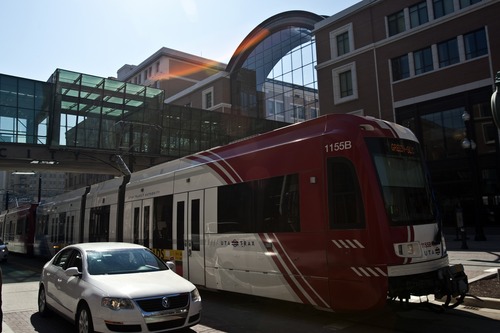This is an archived article that was published on sltrib.com in 2013, and information in the article may be outdated. It is provided only for personal research purposes and may not be reprinted.
The Utah Transit Authority figures the many new rail lines it opened in the last three years attracted $7 billion to $10 billion worth of new development near stations as a side benefit to improving transportation. Since it spent $2.4 billion on those lines, it sounds like a good return on investment.
But a new study says governments get even more bang for their buck in revitalizing areas if they instead build "bus rapid transit" (BRT) systems. While far cheaper to construct, they attract just as much development.
The UTA says there is no need for buyer's remorse for its new TRAX, FrontRunner and streetcar projects — because they do more than revamp areas. But UTA adds that BRT is a focus of its future plans. It is sort of a TRAX on rubber wheels where buses have exclusive lanes, passengers buy tickets from vending machines before boarding on platforms, and buses have priority at intersections.
"We are seeing that mass transit can revitalize cities if governments act wisely — and the type of mass transit providing the best bang for the buck is bus rapid transit," said Walter Hook, chief executive officer of the New York-based Institute for Transportation and Development Policy.
His institute released a report Tuesday, "More Development for Your Transit Dollar," that looked at development along 21 mass transit corridors in 13 cities in North America (but none in Utah). It concluded that BRT generates 31 times more development than the best light rail projects for each dollar spent. TRAX is an example of light rail.
The study said that a new BRT line in Cleveland generated $5.8 billion in transit-oriented development around its stops, while Portland's new blue line light rail generated $6.5 billion. They were the top performers studied among the two types of transit.
But because the Cleveland line cost significantly less to build, the study says Cleveland leveraged 31 times more per dollar spent in attracting new development.
UTA has one partial BRT line so far — the MAX bus on 3500 South in West Valley City and Magna. However, only about a one-mile stretch currently is a true BRT with exclusive lanes for buses.
UTA is planning to soon add a BRT line between Provo and Orem, and is studying another between Taylorsville and Murray.
UTA has many others penciled in on long-range regional transportation plans, including along such places as Redwood Road, the Mountain View Corridor, State Street in Salt Lake County, Washington Boulevard in Weber County, Foothill/Wasatch Drive, 1300 East, 700 East and the Bangerter Highway corridor.
"We are excited to advance the unique benefits provided by BRT, and the potential for transit-oriented development along those corridors in addition to the transit-oriented developments that we have along the rail system," said UTA spokesman Remi Barron.
He adds that "the primary purpose of building mass transit systems is to serve a transportation need, not facilitate development." Barron said the light-rail TRAX has higher capacity than BRT "and is designed to serve a different transportation function" and was determined to be the best mode for the corridors where they were used.
"UTA is seeing great development activity and success around our light-rail system," including the City Creek mall in downtown Salt Lake City, Daybreak developments on the red line in South Jordan and West Valley City's Fairbourne Station on the green line. He adds the soon-to-open Sugar House streetcar has attracted more than $1 billion in new development near it.
"While we would assert that BRT and light rail transit equally facilitate transit-oriented development, the decision to build BRT or LRT involves many considerations, only one of which is the facilitation of transit-oriented development," Barron said.
Hook, with the institute, said, "In these cash-strapped times, how far an investment stretches sparse government dollars is as critical as finding the lowest possible price tag for the project. Bus rapid transit fits perfectly in this narrow window of opportunity."
The study notes that BRT was developed in Brazil and has been embraced by cities in South America, North America and Asia. The biggest BRT system is in Bogota, Colombia, which averages 2 million riders a day.







